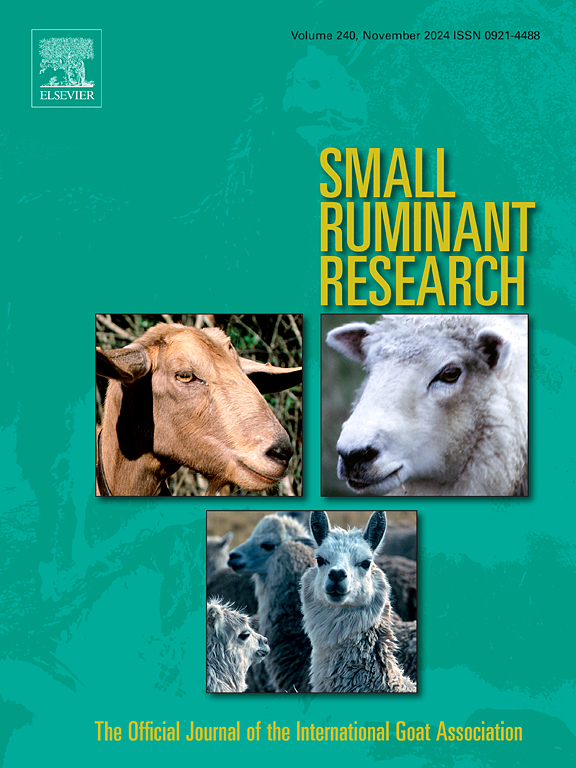Cashew (Anacardium occidentale L.) nut meal could be a promising alternative protein feedstuff for lambs
IF 1.6
3区 农林科学
Q2 AGRICULTURE, DAIRY & ANIMAL SCIENCE
引用次数: 0
Abstract
In today’s livestock landscape, amid shortages and fluctuating feed commodity prices, quest for exploring under-utilised and possibly economical agro-industrial by-products remains key for sustainable farming. In this backdrop, notwithstanding the moderate energy and protein values of cashew nut meal (CNM)—a by-product of the cashew nut processing industry—there appears limited research exploration on it as a prospective feedstuff for lambs. Therefore, the present study was conducted to delineate the effect of inclusion of graded levels of CNM on intake, nutrient digestibility, growth performance, rumen fermentation, and economics in lambs fed Napier Pakchong-1 grass hay-based diet. For this, 24 Mandya ram lambs were divided into four similar experimental groups of six animals each in a completely randomised design based on a comparable body weight (7.9 ± 0.65 kg) and age (3–4 months). The treatments involved four isonitrogenous concentrate feed mixtures (CFM) with CNM included at 0 (T0), 100 (T1), 200 (T2), and 300 g/kg (T3), proportionally replacing soya bean meal and wheat bran. The results of the feeding trial spanning 120 days indicated that CNM had no effect on intake (except ether extract) and digestibility of nutrients, nutritive value of diets, and nutrient selection index among the four groups. The same trend was true for final body weight, average daily gain, and feed conversion (feed-to-gain) ratio. Furthermore, there were no significant (P > 0.05) differences in rumen fermentation pattern, including rumen pH, various nitrogen fractions as well as total- and individual volatile fatty acids among the experimental groups. Similarly, blood biochemistry was also unaffected by the inclusion of CNM in the diet. Beneficially, the use of CNM reduced the overall feed cost for growth to the extent of 5.1 % in group T3 than T0, indicating a modest economic advantage. Overall, CNM presents a promising alternative to conventional protein sources like SBM when included up to 300 g/kg CFM, offering comparable nutrient values without causing any discernible negative influence on key performance metrics and health.
腰果坚果粉是一种很有前途的替代羔羊蛋白饲料
在今天的畜牧业形势下,在饲料商品短缺和价格波动的情况下,探索未充分利用和可能经济的农工副产品仍然是可持续农业的关键。在此背景下,尽管腰果粕(腰果加工工业的副产品)具有中等的能量和蛋白质价值,但将其作为羔羊饲料的研究探索却有限。因此,本研究旨在研究添加不同水平CNM对纳匹尔- pakchon -1草干草基础饲粮羔羊采食量、营养物质消化率、生长性能、瘤胃发酵和经济性的影响。为此,采用完全随机设计,将24只曼迪亚公羊羔羊按体重(7.9 ± 0.65 kg)和年龄(3-4月龄)分为4个相似的试验组,每组6只。试验采用4种等氮浓缩饲料混合物(CFM), CNM浓度分别为0 (T0)、100 (T1)、200 (T2)和300 g/kg (T3),按比例替代豆粕和麦麸。120 d的饲养试验结果表明,CNM对4组仔猪采食量(粗脂肪除外)、营养物质消化率、饲粮营养价值和营养选择指数均无影响。末重、平均日增重和料重比均呈相同趋势。此外,试验组间瘤胃发酵模式,包括瘤胃pH、各氮组分以及总挥发性脂肪酸和个别挥发性脂肪酸均无显著差异(P >; 0.05)。同样,血液生化也不受饮食中含有CNM的影响。有益的是,与T0相比,使用CNM使T3组的生长总饲料成本降低了5.1% %,表明具有适度的经济优势。总的来说,CNM是传统蛋白质来源(如SBM)的一个有希望的替代品,当CFM含量高达300 g/kg时,CNM提供了相当的营养价值,而不会对关键性能指标和健康造成任何明显的负面影响。
本文章由计算机程序翻译,如有差异,请以英文原文为准。
求助全文
约1分钟内获得全文
求助全文
来源期刊

Small Ruminant Research
农林科学-奶制品与动物科学
CiteScore
3.10
自引率
11.10%
发文量
210
审稿时长
12.5 weeks
期刊介绍:
Small Ruminant Research publishes original, basic and applied research articles, technical notes, and review articles on research relating to goats, sheep, deer, the New World camelids llama, alpaca, vicuna and guanaco, and the Old World camels.
Topics covered include nutrition, physiology, anatomy, genetics, microbiology, ethology, product technology, socio-economics, management, sustainability and environment, veterinary medicine and husbandry engineering.
 求助内容:
求助内容: 应助结果提醒方式:
应助结果提醒方式:


